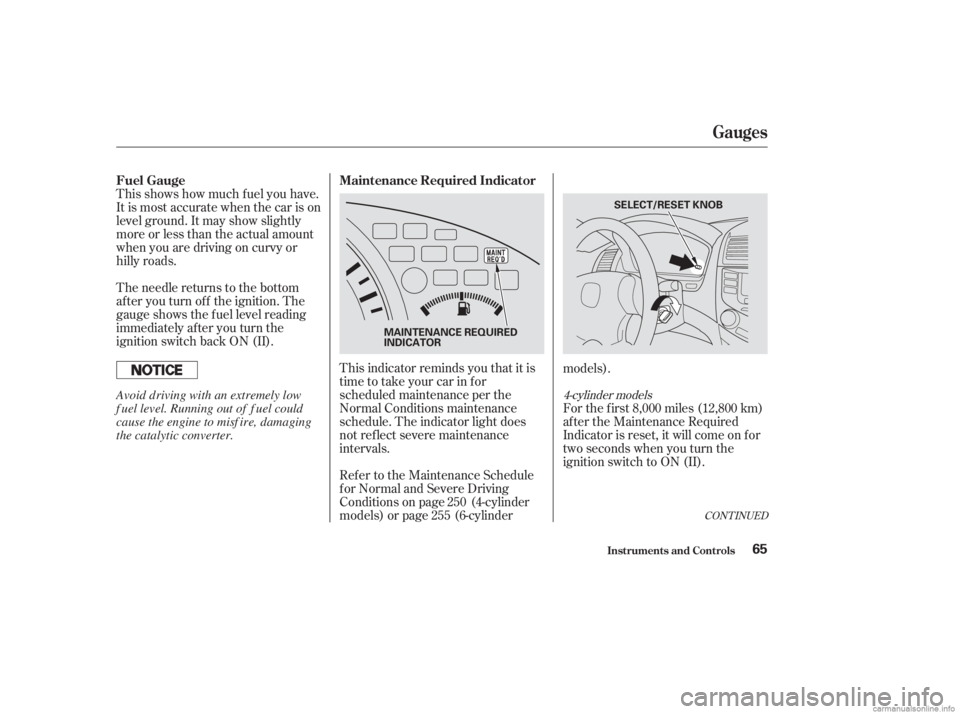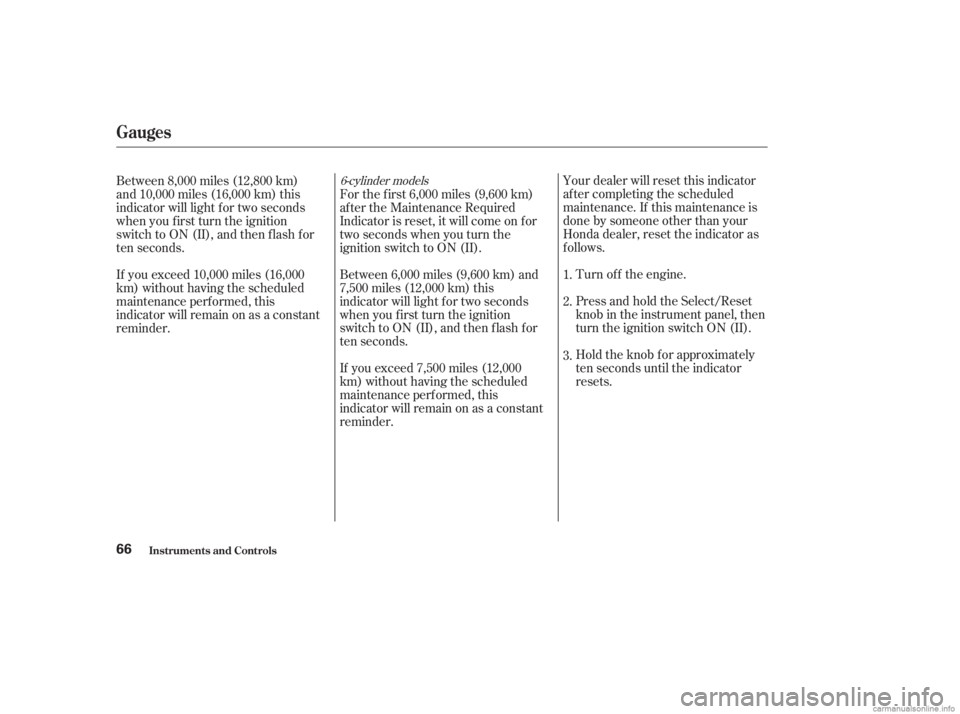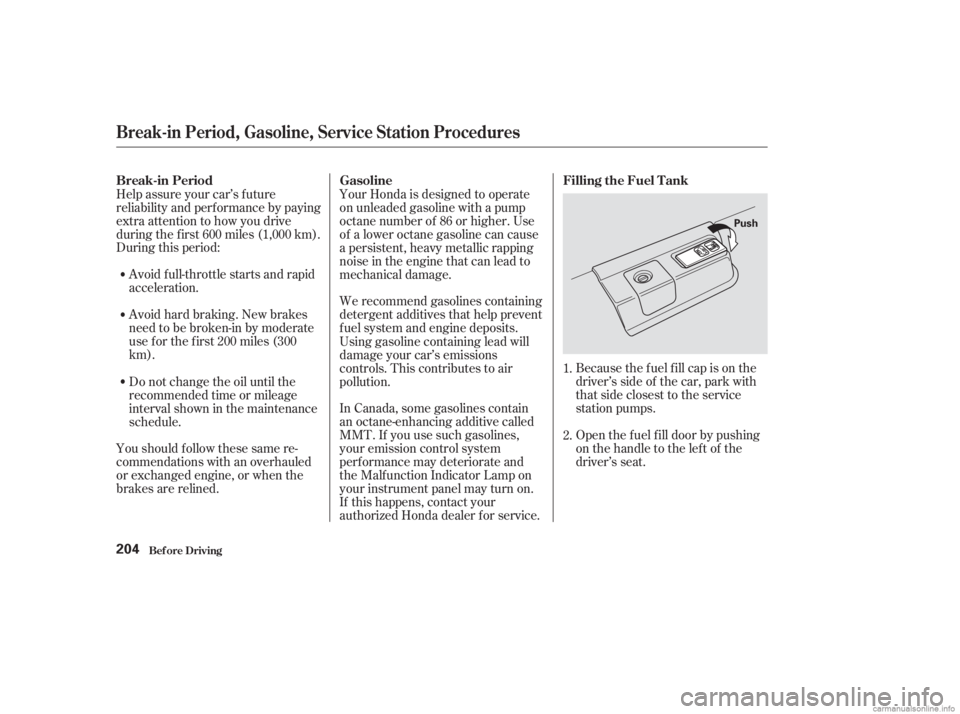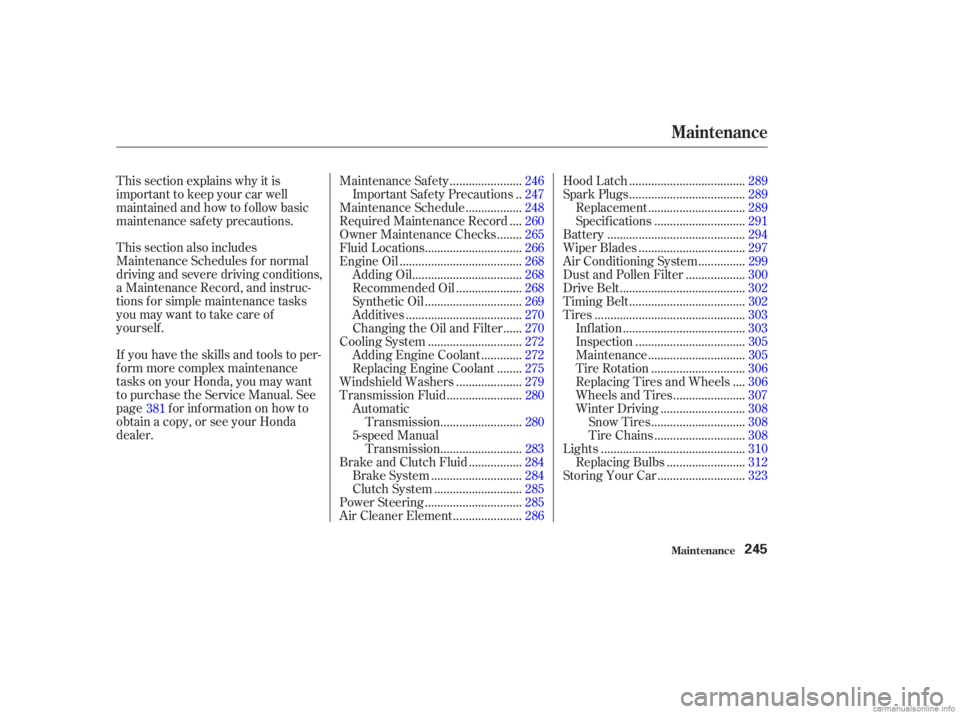2003 HONDA ACCORD SEDAN maintenance schedule
[x] Cancel search: maintenance schedulePage 1 of 395

2003 Accord Sedan Online Reference Owner's Manual Use these links (and links throughout this manual) to navigate through\
this reference.
For a printed owner's manual, click on authorized manuals or go to www.h\
elminc.com.
Contents
Owner's Identification Form
Introduction ........................................................................\
................................................................. i
A Few Words About Safety........................................................................\
........................................ .ii
Your Car at a Glance ........................................................................\
...................................................2
Driver and Passenger Safety ........................................................................\
......................................5
Proper use and care of your car's seat belts, and Supplemental Restraint\
System.
Instruments and Controls........................................................................\
........................................ .55
Instrument panel indicator and gauge, and how to use dashboard and steering column controls.
Comfort and Convenience Features ........................................................................\
..................... .111
How to operate the climate control system, the audio system, and other c\
onvenience features.
Before Driving........................................................................\
..........................................................203
What gasoline to use, how to break -in your new car, and how to load luggage and other cargo.
Driving ........................................................................\
..................................................................... .217
The proper way to start the engine, shift the transmission, and park, pl\
us towing a trailer.
Maintenance........................................................................\
.............................................................245
The Maintenance Schedule shows you when you need to take your car to the\
dealer.
Appearance Care........................................................................\
..................................................... .325
Tips on cleaning and protecting your car. Things to look for if your car \
ever needs body repairs.
Taking Care of the Unexpected........................................................................\
..............................333
This section covers several problems motorists sometimes experience, and\
how to handle them.
Technical Information........................................................................\
............................................ .361
ID numbers, dimensions, capacities, and technical information.
Warranty and Customer Relations (U.S. and Canada)................................................................377
A summary of the warranties covering your new Honda, and how to contact \
us.
Authorized Manuals (U.S. only)........................................................................\
............................. .381
How to order manuals and other tec hnical literature.
Index ........................................................................\
........................................................................\
..... I
Service Information Summary
A summary of information you need when you pull up to the fuel pump.
Page 3 of 395

As you read this manual, you will
f ind inf ormation that is preceded by
asymbol. This
inf ormation is intended to help you
avoid damage to your Honda, other
property, or the environment.
Several warranties protect your new Honda. Read the warranty booklet
thoroughly so you understand the coverages and are aware of your rights
and responsibilities. One of the best ways to enhance the enjoyment of your new Honda is to
read this manual. In it, you will learn how to operate its driving controls and
convenience items. Af terwards, keep this owner’s manual in your car so you
can ref er to it at any time.
Maintaining your car according to the schedules given in this manual helps
to keep your driving trouble-f ree while it preserves your investment. When
your car needs maintenance, keep in mind that your Honda dealer’s staf f is
specially trained in servicing the many systems unique to your Honda. Your
Honda dealer is dedicated to your satisf action and will be pleased to answer
any questions and concerns.
Calif ornia Proposition 65 Warning This product contains or emits chemicals known to the State of
Calif ornia to cause cancer and birth def ects or other reproductive harm. Congratulations! Your selection of a 2003 Honda Accord was a wise
investment. It will give you years of driving pleasure.
Introduction
WARNING:
i
Page 9 of 395

Excessive speed is a major f actor in
crash injuries and deaths. Generally,
the higher the speed the greater the
risk, but serious accidents can also
occur at lower speeds. Never drive
f aster than is saf e f or current
conditions, regardless of the
maximum speed posted.
While airbags can save lives, they
can cause serious or fatal injuries to
occupants who sit too close to them,
or are not properly restrained.
Inf ants, young children, and short
adults are at the greatest risk. Be
sure to f ollow all instructions and
warnings in this manual. (See page
.)
Children are saf est when they are
properly restrained in the back seat,
notthefrontseat.Achildwhoistoo
smallforaseatbeltmustbeproperly
restrained in a child saf ety seat. (See
page .) Having a tire blowout or a
mechanical f ailure can be extremely
hazardous. To reduce the possibility
of such problems, check your tire
pressures and condition f requently,
and perform all regularly scheduled
maintenance. (See page .)
You’ll f ind many saf ety
recommendations throughout this
section, and throughout this manual.
Therecommendationsonthispage
are the ones we consider to be the
most important.
A seat belt is your best protection in
all types of collisions. Airbags
supplement seat belts, but airbags
are designed to inf late only in a
moderate to severe f rontal collision.
So even though your car is equipped
with airbags, make sure you and
your passengers always wear your
seat belts, and wear them properly.
(See page .)
Alcohol and driving don’t mix. Even
one drink can reduce your ability to
respond to changing conditions, and
your reaction time gets worse with
every additional drink. So don’t drink
and drive, and don’t let your f riends
drink and drive, either.7
15
21 248
Driver and Passenger Saf ety
Important Saf ety Precautions
Always Wear Your Seat Belt
Be Aware of Airbag Hazards Control Your Speed
Restrain All Children K eep Your Car in Saf e Condition
Don’t Drink and Drive
6
Page 68 of 395

This shows how much f uel you have.
It is most accurate when the car is on
level ground. It may show slightly
more or less than the actual amount
whenyouaredrivingoncurvyor
hilly roads.
The needle returns to the bottom
after you turn off the ignition. The
gauge shows the f uel level reading
immediately af ter you turn the
ignition switch back ON (II).This indicator reminds you that it is
time to take your car in for
scheduled maintenance per the
Normal Conditions maintenance
schedule. The indicator light does
not ref lect severe maintenance
intervals.For the f irst 8,000 miles (12,800 km)
after the Maintenance Required
Indicator is reset, it will come on f or
two seconds when you turn the
ignition switch to ON (II).
Ref er to the Maintenance Schedule
f or Normal and Severe Driving
Conditions on page (4-cylinder
models) or page (6-cylinder models).
250
255
CONT INUED
4-cylinder models
Gauges
Inst rument s and Cont rols
Maintenance Required Indicator
Fuel Gauge
65
MAINTENANCE REQUIRED
INDICATOR SELECT/RESET KNOB
Avoid driving with an extremely low
f uel level. Running out of f uel could
cause the engine to misf ire, damaging
the catalytic converter.
Page 69 of 395

Your dealer will reset this indicator
af ter completing the scheduled
maintenance. If this maintenance is
done by someone other than your
Honda dealer, reset the indicator as
f ollows.Turn of f the engine.
Press and hold the Select/Reset
knob in the instrument panel, then
turn the ignition switch ON (II).
Hold the knob f or approximately
ten seconds until the indicator
resets.
For the f irst 6,000 miles (9,600 km)
af ter the Maintenance Required
Indicator is reset, it will come on f or
two seconds when you turn the
ignition switch to ON (II).
Between 6,000 miles (9,600 km) and
7,500 miles (12,000 km) this
indicator will light f or two seconds
when you first turn the ignition
switch to ON (II), and then flash for
ten seconds.
If you exceed 7,500 miles (12,000
km) without having the scheduled
maintenance perf ormed, this
indicator will remain on as a constant
reminder.
Between 8,000 miles (12,800 km)
and 10,000 miles (16,000 km) this
indicator will light f or two seconds
when you first turn the ignition
switch to ON (II), and then flash for
ten seconds.
If you exceed 10,000 miles (16,000
km) without having the scheduled
maintenance perf ormed, this
indicator will remain on as a constant
reminder.
1.
2.
3.6-cylinder models
Gauges
Inst rument s and Cont rols66
Page 207 of 395

During this period:Avoid full-throttle starts and rapid
acceleration. We recommend gasolines containing
detergent additives that help prevent
f uel system and engine deposits.
Avoidhardbraking.Newbrakes
need to be broken-in by moderate
use f or the f irst 200 miles (300
km).
Open the f uel f ill door by pushing
onthehandletotheleftof the
driver’s seat.
Help assure your car’s f uture
reliability and perf ormance by paying
extra attention to how you drive
during the f irst 600 miles (1,000 km).
Because the f uel f ill cap is on the
driver’s side of the car, park with
that side closest to the service
station pumps.
In Canada, some gasolines contain
an octane-enhancing additive called
MMT. If you use such gasolines,
your emission control system
perf ormance may deteriorate and
the Malf unction Indicator Lamp on
your instrument panel may turn on.
If this happens, contact your
authorized Honda dealer f or service. Using gasoline containing lead will
damage your car’s emissions
controls. This contributes to air
pollution.
Youshouldfollowthesesamere-
commendations with an overhauled
or exchanged engine, or when the
brakes are relined. Do not change the oil until the
recommended time or mileage
intervalshowninthemaintenance
schedule. Your Honda is designed to operate
on unleaded gasoline with a pump
octane number of 86 or higher. Use
of a lower octane gasoline can cause
a persistent, heavy metallic rapping
noise in the engine that can lead to
mechanical damage.
1.
2.
Bef ore Driving
Break-in Period GasolineFilling the Fuel Tank
Break-in Period, Gasoline, Service Station Procedures
204
Push
Page 214 of 395

A cold engine uses more f uel than a
warm engine. It is not necessary to
‘‘warm-up’’ a cold engine by letting it
idle f or a long time. You can drive
away in about a minute, no matter
how cold it is outside. The engine
will warm up f aster, and you get
better f uel economy. To cut down on
the number of ‘‘cold starts,’’ try to
combine several short trips into one.
You can improve f uel economy by
driving moderately. Rapid acceler-
ation, abrupt cornering, and hard
braking use more f uel.
Always drive in the highest gear that
allows the engine to run and acceler-
ate smoothly.
The air conditioning puts an extra
load on the engine which makes it
usemorefuel.Turnoff theA/Cto
cut down on air conditioning use.
Use the f low-through ventilation
when the outside air temperature is
moderate.
The condition of your car and your
driving habits are the two most
important things that affect the fuel
mileage you get.
Always maintain your car according
to the maintenance schedule. This
will keep it in top operating condition.
Depending on traf f ic conditions, try
to maintain a constant speed. Every
time you slow down and speed up,
your car uses extra f uel. Use the
cruise control, when appropriate, to
increase f uel economy.
An important part of that mainte-
nance is the
(see page ). For
example, an underinf lated tire
causes more ‘‘rolling resistance,’’
which uses f uel. It also wears out
f aster, so check the tire pressure at
least monthly.
In winter, the build-up of snow on
your car’s underside adds weight and
rolling resistance. Frequent cleaning
helps your f uel mileage and reduces
thechanceof corrosion. 265 Driving Habits
Owner Maintenance
Checks Car Condition
Fuel Economy
Bef ore Driving211
Page 248 of 395

This section also includes
Maintenance Schedules f or normal
driving and severe driving conditions,
a Maintenance Record, and instruc-
tions f or simple maintenance tasks
you may want to take care of
yourself .
If you have the skills and tools to per-
f orm more complex maintenance
tasks on your Honda, you may want
to purchase the Service Manual. See
page f or inf ormation on how to
obtain a copy, or see your Honda
dealer. This section explains why it is
important to keep your car well
maintained and how to f ollow basic
maintenance saf ety precautions.......................
Maintenance Saf ety .246
.
Important Safety Precautions . 247
.................
Maintenance Schedule . 248
...
Required Maintenance Record . 260
.......
Owner Maintenance Checks . 265
..............................
Fluid Locations .266
......................................
Engine Oil .268
..................................
Adding Oil .268
....................
Recommended Oil .268
..............................
Synthetic Oil .269
....................................
Additives .270
.....
Changing the Oil and Filter . 270
.............................
Cooling System .272
............
Adding Engine Coolant . 272
.......
Replacing Engine Coolant . 275
....................
Windshield Washers .279
.......................
Transmission Fluid .280
Automatic .........................
Transmission .280
5-speed Manual .........................
Transmission .283
................
Brake and Clutch Fluid . 284
............................
Brake System .284
...........................
Clutch System .285
..............................
Power Steering .285
.....................
Air Cleaner Element .286 ....................................
Hood Latch .289
....................................
Spark Plugs .289
..............................
Replacement .289
............................
Specif ications .291
...........................................
Battery .294
.................................
Wiper Blades .297
..............
Air Conditioning System . 299
..................
Dust and Pollen Filter . 300
.......................................
Drive Belt .302
....................................
Timing Belt .302
...............................................
Tires .303
......................................
Inf lation .303
..................................
Inspection .305
..............................
Maintenance .305
.............................
Tire Rotation .306
...
Replacing Tires and Wheels . 306
......................
Wheels and Tires .307
..........................
Winter Driving .308
.............................
Snow Tires .308
............................
Tire Chains .308
.............................................
Lights .310
........................
Replacing Bulbs .312
...........................
Storing Your Car .323
381
Maintenance
Maint enance245